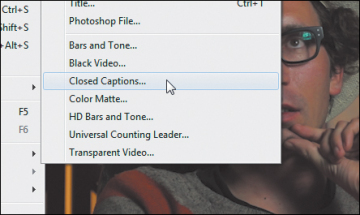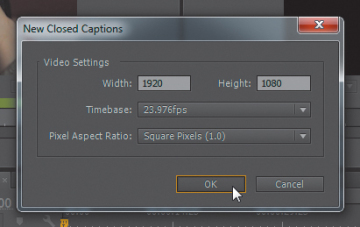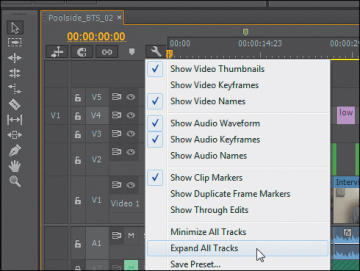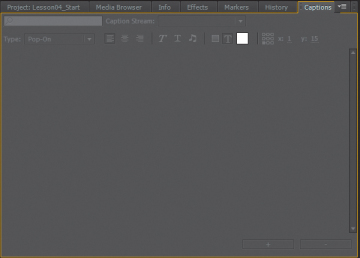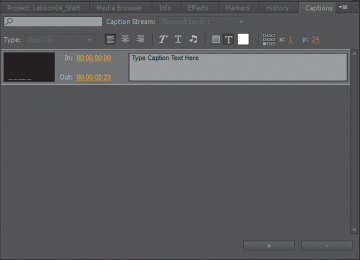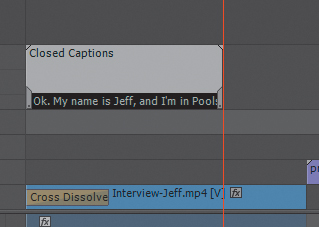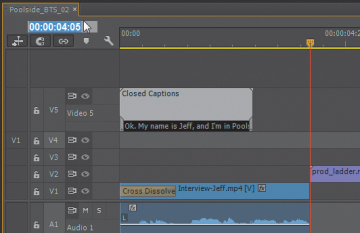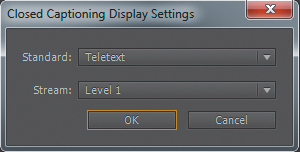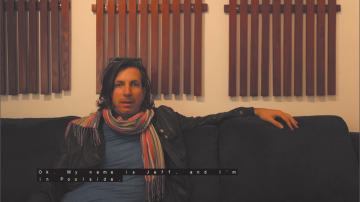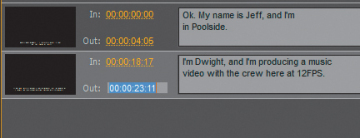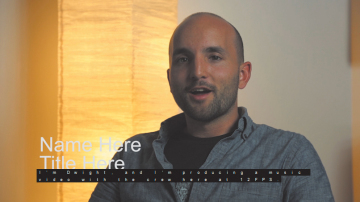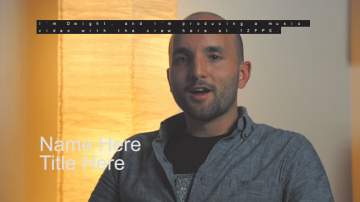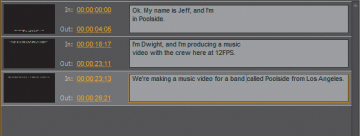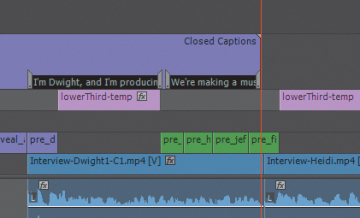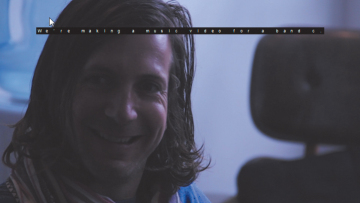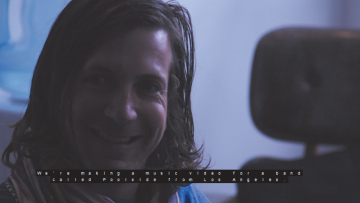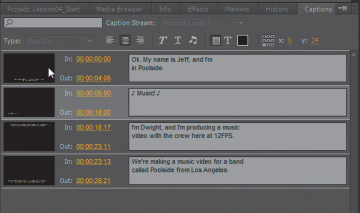- Beginning this lesson
- Trimming clips in the Timeline
- Incorporating RED footage
- Adding transitions
- Creating effects in Adobe Premiere Pro
- Adding titles with the Adobe Premiere Pro Title tool
- Editing closed captions
- Stabilizing footage with the Warp Stabilizer
- Rendering your Timeline
- Posting to Creative Cloud for review
- Review questions
- Review answers
Editing closed captions
Whereas previous versions of Adobe Premiere Pro allowed you to import closed caption files and add them to your sequences, Adobe Premiere Pro CC now allows you to create closed captions from scratch. You can enter closed caption text, and adjust its timing, position, and color. You can also export a closed caption “sidecar” file with your sequence and even embed the closed captions in a Quicktime .mov file.
In this exercise, you will learn the basics of creating closed captions in your Adobe Premiere Pro sequence.
- Press the Home key to move the Timeline playhead to the beginning of your sequence.
- Choose File > New > Closed Captions.
The New Closed Captions window will appear. Accept the default Video Settings by clicking OK.
Another New Closed Captions window appears, this time prompting you to choose a Standard and Stream.
- From the Standard menu, choose Teletext, and leave Stream set to Level 1. Click OK.
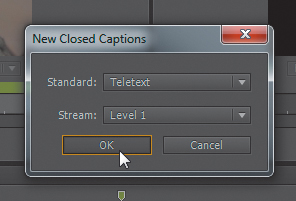
A new Closed Captions clip will appear in the Project panel.
- Select and drag this to the Timeline at the very beginning of your sequence, above track Video 4, thus automatically creating track Video 5.
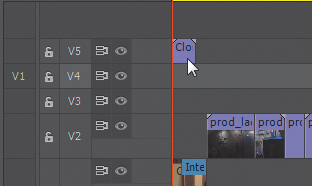
- Click the Timeline Display Options wrench icon, then choose Expand All Tracks from the menu. This way, you will be able to see any captions within the Closed Captions clip.
- Choose Window > Captions to bring up the Captions panel. Here you will be able to type and edit captions in the Closed Captions clips that you make.
The Captions panel interface has a search field at the top left, so that you can search for dialogue by keyword.
Below that, and relevant to this exercise, are icons to left-, center-, and right-align text.

Next to that are icons for creating italicized and underlined text and making characters to indicate music in your captions.

Next to that, you will see icons for background color and text color, along with a color patch that will show the applied color of background or text, depending on whether the background color or text color icons are selected.

To the right of those is the Position Caption Block icon, for easy placement of text onscreen. You can also enter x and y values instead.

Below this row of icons is where the caption fields are located.
- Select the Closed Captions clip in the Timeline. You will see its only caption in the Captions panel, with the default Type Caption Text Here.
- Press the spacebar to play the first few seconds of your sequence, in which we hear Jeff say “OK. My name is Jeff, and I’m in Poolside.”
- In the Captions panel, select the text Type Caption Text Here and replace it with OK. My name is Jeff, and I’m in Poolside.
Notice that the Closed Captions clip in the Timeline is too short.
- Snap the Timeline playhead to the tail of Interview-Jeff.mp4, and note the timecode, 00:00:04:05.
- Select the timecode at the top left of the Timeline, then press Command+C (Ctrl+C) to copy it.
- In the Captions panel, select the Out value for the caption, and press Command+V (Ctrl+V) to paste the timecode.
Scrub through this first Closed Captions clip in the Timeline and you won’t see the closed caption text. That’s because you must first enable closed captioning display in the Program Monitor.
- At the top right of the Program Monitor, click the options menu icon, then choose Closed Captioning Display > Enable.
- Click the Program Monitor options menu again, then choose Closed Captioning Display > Settings. A Closed Captioning Display Settings window appears.
- From the Standard menu, choose Teletext and set the Stream menu to Level 1. Click OK.
Scrub through the clip again, and you will notice that the word Poolside is being clipped at the far right of the line of text in the Program Monitor.
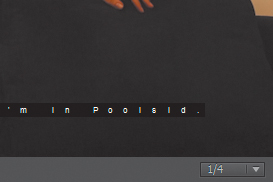
- To fix this, go to the Captions panel, place the text cursor between I’m and in, then press Return (Enter) to create a line break.

The closed caption text will be fixed accordingly in the Program Monitor.
A Closed Captions clip can contain more than one chunk of caption text so that you don’t have to create a separate clip for every bit of dialogue in your sequence. You can make a new caption for such a clip by clicking the + button at the bottom of the Captions panel.
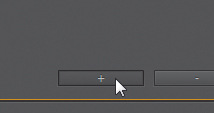
- Scrub the Timeline playhead to Interview-Dwight1-C1.mp4 and press the spacebar to listen to the dialogue.
- In the Captions panel, click the + button to create a new caption.
You don’t want to transcribe all of what Dwight says in this one clip into a single caption, because, first of all, closed captions are meant to be read as the on-camera speaker is talking, and also because a caption within a Closed Captions clip can only display so much text at once. So you will sometimes, like in this case, want to split up a long chunk of dialogue into multiple captions.
- In the new caption field in the Captions panel, type I’m Dwight, and I’m producing a music video with the crew here at 12FPS. Make sure to put a line break between music and video.
- In the Timeline, select the timecode and press Command+C (Ctrl+C) to copy. Then go to the caption you just made in the Captions panel, select the value for In, and then press Command+V (Ctrl+V) to paste.
- In the Timeline, scrub the playhead to where this bit of dialogue ends, at 00:00:23:11. Select the timecode, and press Command+C (Ctrl+C) to copy it. Then go to the caption in the Captions panel, select the value for Out, and press Command+V (Ctrl+V) to paste.
- Back in the Timeline, select the tail of the Closed Captions clip and drag it to the right so that you can see the caption text in the Program Monitor.
Notice that the caption text is being displayed at the bottom of the frame. You don’t want this bit of closed caption text to be at the bottom of the frame because it would be displayed over the lower third graphic that you will make later.
- So, in the Captions panel, select all of the text in the second caption field, then press the upper left square in the Position Caption Block icon to move this caption to the upper-left corner of the frame.
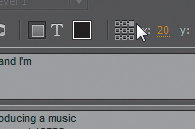
- Now scrub ahead in the Timeline to where Dwight begins to say “We’re making a music video....”
- Select the timecode and press Command+C (Ctrl+C) to copy it.
Now make a new caption for the second bit of Dwight’s sound bite.
- In the Captions panel, click the + button to make a new caption field.
- Select its In value, then press Command+V (Ctrl+V) to paste the timecode.
- In the text field, transcribe the bit of what Dwight says: We’re making a music video for a band called Poolside, from Los Angeles.
- In the Timeline, scrub the playhead to the end of this bit of dialogue. Select the timecode, and press Command+C (Ctrl+C) to copy it.
- In the Captions panel, for this caption, select the value for Out, then press Command+V (Ctrl+V) to paste the timecode value.
- In the Timeline, select the tail of the Closed Captions clip and drag it to the right, to the end of Dwight’s dialogue.
Notice that the closed caption text needs a couple of line breaks.
- Go back to the Captions panel, and enter line breaks in the text field as needed.
- Select all of the text, then click the bottom left square in the Position Caption Block icon, so that this caption is placed at the bottom of the frame.
You also want to make captions for when there is only music playing.
- Scrub the Timeline playhead back to the right before Dwight’s first caption, at 00:00:18:00. In this case, it doesn’t have to be exact.
- Select the timecode value and press Command+C (Ctrl+C) to copy it.
- In the Captions panel, click the + button to create a new caption.
- Select the Out value and press Command+V (Ctrl+V) to paste. If you tried pasting this to the In value, you discovered that Adobe Premiere Pro wouldn’t let you because it assumed that the Out value would come after the last caption you made, and there was already a caption there. So by setting the Out value to where there was no caption, Adobe Premiere Pro will automatically set the In value to be one frame before, at 00:00:17:23.
- Now select this caption’s In value and enter 00:00:05:00 (or just type 500).
- In this caption’s text field, click the Insert Music Note icon. This will create a caption that shows a music note, indicating that only music is heard here.
You should now understand the basics of creating closed captions in Adobe Premiere Pro. For the sake of expediency, this exercise will not walk you through every step of transcribing all of the remaining dialogue and creating closed captions for the rest of the video. Take some time to do this on your own.
When you are finished creating your closed captions, do the following:
- Select the Closed Captions clip in track Video 5 and press Delete. When you learn about exporting your project as a movie file, you will put the Closed Captions clip back in your sequence.
- In the Project panel, select the Closed Captions clip and drag it onto the Graphics bin.
- Press Command+S (Ctrl+S) to save your project.
